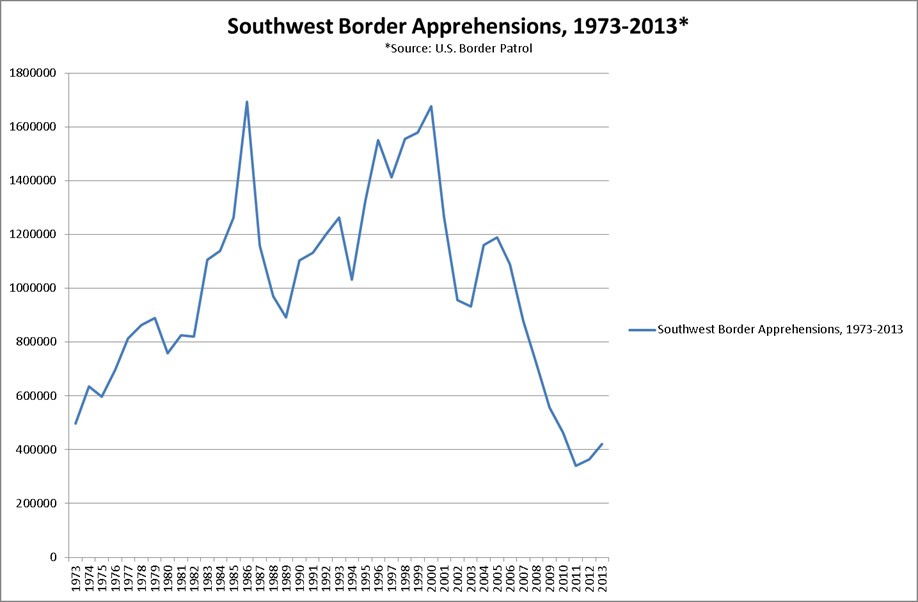Border security is and always has been an important piece of the immigration reform debate. But it is just that, a single piece. The United States cannot simply spend or enforce its way to a solution on illegal immigration. When it comes to border security, we need effective enforcement that is humane and transparent and takes into account the impact on the 15 million people who live along our borders. Smart enforcement and border security, coupled with immigration reforms that promote legal immigration, can improve security at the border and make our ports of entry more efficient for commerce.
On Capitol Hill, “border security first” is a common refrain in any conversation about immigration reform. Senate bill S. 744, the Border Security, Economic Opportunity, and Immigration Modernization Act of 2013, mandated that an additional $38 billion be spent on border security and that the size of the border patrol be doubled. This approach failed to take into account the progress already made at the border but set achievable conditions for legalization to move forward. Many members of the House of Representatives have echoed that the border must be secure before Congress addresses other parts of the broken immigration system. That would require a determination — by an entity to be determined — that the border were secure before other provisions of immigration reform legislation could take effect.
Key Points
- Border Security is a federal responsibility. A secure border is essential to our nation’s well-being, and the federal government must define what constitutes a secure border. Obtaining input from border communities is crucial: The 15 million people living along our nation’s borders will bear the brunt of any additional security. However, immigration reform for our country must not rest on the permission of individuals with parochial or political interests. Congress must consider many perspectives but come to its own decision.
- Border security triggers must not indefinitely delay reform. Legislative proposals that require a secure border before other reforms could occur must include clearly definable metrics that are attainable, do not indefinitely hold up immigration reform and are not dependent on future appropriations. Although a fully secure border is a worthy goal, it never will be completely sealed, and proposals that insist on this kind of unattainable goal are nothing more than roadblocks intended to stop immigration reform.
- Immigration reform must include resources for ports of entry. Trade and commerce at U.S. land ports of entry have been increasing significantly. In 2010, the value of cross-border travel at the U.S. land ports and exports with Mexico and Canada totaled more than $791 billion, with more than 13,000 trucks bringing more than $630 million worth of goods into the U.S. from Mexico every day. The revenue from trade at the border generates jobs for Americans not just in border states but all over the nation. However, annual delays at our land ports of entry cost 26,000 U.S. jobs and $6 billion in lost economic output each year. Customs and Border Protection’s Office of Field Operations, which oversees the flow of commerce at ports, is understaffed. A 2012 Texas Border Coalition report found that, because enforcement resources have been so focused between land ports of entry, individuals trying to enter the U.S. between the land ports of entry have a 90 percent probability of being apprehended, but those trying to enter illegally through a land port have only a 28 percent chance of being apprehended. The Forum believes that as part of immigration reform, Congress needs to fund more Border Patrol officers at our ports of entry and modernize them to increase the flow of commerce.
- Immigration reform must ensure accountability of Border Patrol officers. Border security policies set by Congress have driven the Border Patrol’s rapid size increase. The Border Patrol is currently mandated to maintain a minimum of 21,370 agents at any given time, up from 14,923 in fiscal year 2007. As the size of the Border Patrol has expanded rapidly, so has the number of complaints against Border Patrol agents. In 2009, complaints increased 50 percent from the previous year. However, resources allocated to offices charged with investigating complaints, such as the Department of Homeland Security Office of the Inspector General, have not kept pace. Additional accountability measures for Border Patrol officers must include investigations into excessive use of force, accountability for those involved, additional training and mandatory body cameras for agents.
Our Borders Are As Secure As Ever
In 2007, Senate immigration reform legislation contained border security and other enforcement “triggers” that had to be met before legalization of undocumented immigrants would take effect. While the legislation did not pass, the government continued to tighten border security, and immigration enforcement increased to record levels. Many of the security benchmarks contained in the 2007 legislation have now been met or surpassed.
- Personnel: The number of Border Patrol agents has increased by more than 50 percent since 2006. Also, thousands of personnel from other law enforcement agencies, as well as National Guard troops, work in task forces concerned with border security.
- Fencing: Out of the 652 miles that the Border Patrol feels is operationally necessary, 651 miles of border fencing had been built, covering almost the entire southern border and including double fencing in many areas.
- Technology: Sophisticated surveillance technology acts as a force multiplier for our agents on the border. The Border Patrol has deployed remote video surveillance systems with day and night cameras, thermal imaging systems and radiation portal monitors. The Border Patrol also operates Predator B unmanned aerial drones that provide surveillance across almost the entire southern border.
- Detention and Deportation: Enforcement has reached record levels in recent years. In Fiscal Year 2013, Immigration and Customs Enforcement (ICE) detained 441,000 people, and more than 2 million people were deported between January 2009 and September 2014.
This buildup in enforcement has had significant deterrent effects. There will always be periodic surges in border crossings but apprehensions of individuals at the border — a measure used to estimate the number of people trying to cross the border illegally — reached 40-year lows in 2013.
The Bottom Line
A singular focus on immigration enforcement will not result in a workable immigration process. Certainly, we must do what we can to ensure that real threats cannot exploit our borders to do harm. But at this time of fiscal discipline, continuing to throw unlimited sums of money and resources at increasing border security to chase an impossible goal of a sealed border is not an effective use of resources. Heads of border agencies under both Republican and Democratic administrations have stated that the best way to improve border security is to fix the immigration system by providing legal avenues for workers to enter the United States when needed and allow families to reunify. Such legal immigration measures will allow law enforcement and border officials to devote fewer resources toward economic migrants and more resources toward the true criminal and terrorist threats.


